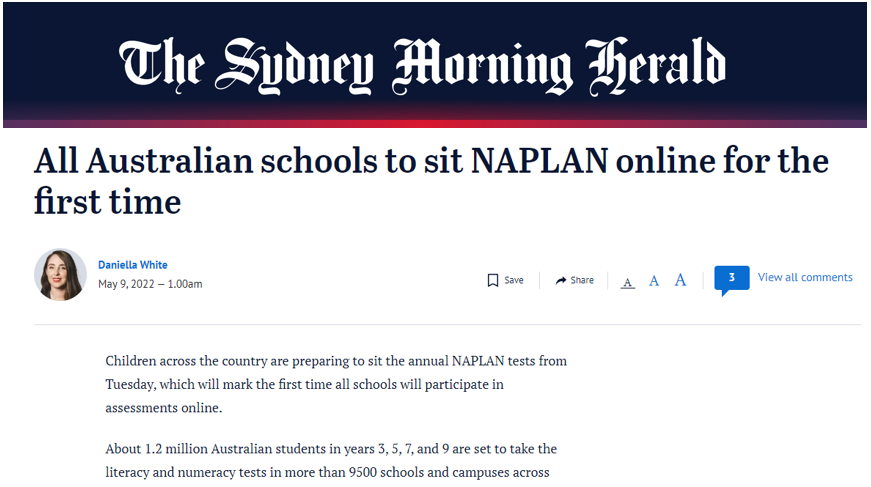Digitising NAPLAN: The transformation of Australia’s national assessment program
Digitising NAPLAN: The transformation of Australia’s national assessment program.
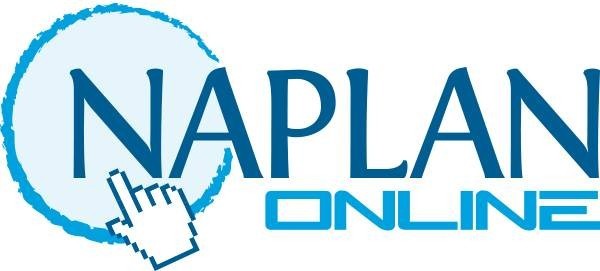
In 2013, Australia’s education ministers coalesced around the idea that students, being increasingly digitally native, would engage better with standardised tests when delivered in online form, versus traditional pen and paper. They understood that the digital delivery of Australia’s national assessment program, NAPLAN, would allow the tests to adapt to each student’s skills and learning maturity in a way that pen and paper couldn’t.
Behind the digital transformation journey of NAPLAN
Since its introduction in 2008, NAPLAN has been managed by the Australian Curriculum, Assessment and Reporting Authority (ACARA).
When ministers resolved to bring NAPLAN online, they chose non-profit Education Services Australia (ESA) to procure, supervise and operationalise a suitable online solution. It made perfect sense – ESA is owned by the nine education ministers and was founded to do this kind of work on behalf of individual state education authorities instead of the states doing it themselves at the cost of uniformity. Janison was one of the three providers secured to work within the consortium and deliver the project.
It’s clear that young people are more engaged by technology than by pen and paper.
 Andrew Smith
Andrew Smith
Chief Executive Officer, Education Services Australia (ESA)
Digitisation of a public benefit project on a nationwide scale remains a lofty goal today – and in 2015, when the partnership between ACARA, ESA and Janison began, it was even more so. There would be zero tolerance for failure with such a public undertaking. Therefore, Janison needed a cloud partner with the same professionalism and quality. That partner would be Microsoft, bringing its ability to host a proposed cloud solution in regional Azure data centres.
The idea took shape to the credit of the visionaries in the room back in 2015. It became the incredible journey we know today as the digital transformation of NAPLAN.
Where it began: Addressing the shortcomings of pen-and-paper tests
Students of the early 2000s and before that time would undoubtedly be familiar with the typical conversation on leaving an exam room.
“Did you find that hard? I thought I wasn’t going to finish on time!”
“No, I found that one easy. I had nothing to do for the last 30 minutes.”
Perhaps these two theoretical students achieved the same results. Yet, no educator would know that one maybe needs a different level of support from the other.
For many years before digitisation, for both high and lower performers, paper-based school examinations, in their static physical format, had inherent limitations when it came to measuring a more nuanced grasp of what students knew or didn’t know. Every student sat the same test. Therefore, it was necessary to pitch the pen-and-paper NAPLAN test questions at the middle of the scope of students’ capability, with some extension at either end.
Add to this that students were already overwhelmingly digital in their everyday lives, choosing texts or instant messaging over writing or calling, streaming content over watching television, et cetera, to the point that educators could no longer ignore these preferences.
“It’s clear that young people are more engaged by technology than by pen and paper,” says Andrew Smith, ESA Chief Executive. “Therefore, we understood that we could better engage students in the test using technology.”
Modernising student engagement was just one of the objectives for the digitisation of NAPLAN, which was first introduced in 2008 to consistently monitor literacy and numeracy levels of Year 3, 5, 7 and 9 students. As years passed, the limitations of manual exam delivery grew, falling into a number of broad categories:
- Equity: Equity of access is imperative for a national testing program, especially in a country the size of Australia, with its dispersed population. That said, its varying degrees of internet bandwidth meant equity would not automatically be a given with digitisation either – a point that would require bespoke solutions for certain locations.
- Performance: The pressing matter of NAPLAN results turnaround times had always been frustrating for schools, parents and students. It could take up to three to four months for students to receive their results from the pen-and-paper format of the test – delaying teachers’ ability to plan and implement targeted teaching interventions.
- Security: Of course, there was also the opportunity to address the vulnerability of paper forms to breaches in security protocols, such as exams falling into the wrong hands or test booklets going missing in transit altogether.
- Scalability and futureproofing: Purposefully designing the system to be able to scale and flex to meet increasing student populations and to incorporate new test requirements was necessary for futureproofing, not to mention avoiding the need for a costly reconstruction further down the line.
All these factors became critical drivers for digitisation.
Of course, such a significant change affecting the nationwide schooling system called for a substantial technological effort requiring cooperation across numerous parties. Eight jurisdictions, states and territories, plus the Commonwealth, would need to agree on key aspects of the program collectively, or else it could not move forward. And while this undertaking would be huge at the system level, schools’ individual change management processes would arguably be more significant.
Still, a countrywide NAPLAN examination system, delivered in a relatable way for students and able to adapt to the style and aptitude of individuals, represented a compelling opportunity. ESA, with the support of Janison and Microsoft, forged ahead.
This initiative started in 2015 when we signed an agreement with ESA to build a NAPLAN Online platform. It’s taken since 2015 to build the platform with all the various performance credentials and benchmarks and get to a point where we’re now at 1.2 million students online. So now we’re here and super excited about that.

Derek Welsh
Chief Operating Officer, Janison
Scoping the technology and selecting a trusted provider
ESA put out feelers for an organisation capable of delivering a digital NAPLAN test and selected Janison as its delivery partner. Together they engaged multiple jurisdictions to gather functional specifications and agree on priority processes. Educators and governments already trusted Janison’s digital assessment platform Insights to deliver, mark and analyse tests for hundreds to millions of test takers across the years, which made customising it the perfect starting point.
Consistency would be essential, even though to some extent states and territories had evolved their own NAPLAN delivery processes independently over time. However, the top priority would be to ensure, through technology, that the student experience would be as consistent and smooth as possible with no interruptions nor distraction from the tools used to deliver it.
“The student experience has been the priority since the program’s inception,” says Smith. “Some children enjoy a test setting; others find it stressful. We needed to accommodate them all.”
“We’re also conscious that teachers administering the test within classrooms and within schools have varying levels of comfort with using technology, so it was also a significant priority to create interfaces and administrative processes that could be easily managed by a teacher.”
Equally, ensuring the project’s success meant individual schools upgrading their internet connectivity, local infrastructure and hardware to handle many simultaneous students sufficiently. They would also need to train administrators and implement programs to raise digital literacy among school staff. Therefore, a part of the challenge would be coordinating test-ready preparation nationwide.
“So as much as there was great excitement about the opportunity, there was certainly an understanding that this was not going to be a simple task because of the amount of change it might require across education at all levels,” says Smith.
We’re conscious that teachers administering the test within classrooms have varying levels of comfort with using technology, so it was a significant priority to create interfaces and administrative processes that could be easily managed by a teacher.
Andrew Smith
Planning for the unknown
Rising to the challenge, Janison sat down with its technology partner Microsoft to architect a platform that would meet these current needs and scale for the future – whatever that might bring. “Most solutions get re-architected and retooled every couple of years. For us, it’s a constant process with Microsoft to figure out what will be the next big technology development and how we should incorporate it,” says Welsh.
Scalability is a big part of that. With populations increasing and digital tests evolving, a digital NAPLAN absolutely must be able to scale seamlessly without refactoring the underlying technology infrastructure. “We used around 35 different types of Azure services to build the NAPLAN Online platform. One of those is a microservices layer that allows us to achieve elastic scale to support NAPLAN far into the future,” Welsh says.
“We leaned on Microsoft’s capacity for hyper-scale clouds that could enable the heavy lifting required for NAPLAN. And we tested far beyond current expectations for concurrent student access, to 450,000. In some cases, we went even further, testing to 600,000 while leveraging the scalability of Microsoft Azure to deliver that sort of volume. We can’t think of anybody else in the world managing that volume of simultaneous delivery for a school exam,” he adds.
NAPLAN’s scale is unbelievable. We’re talking about more than a million students taking three million tests within two weeks. At its peak, we’d be delivering a million tests in one day with close to 315,000 students online simultaneously, making it one of the biggest school online assessment events in the world. NAPLAN cannot fail, nor can there be any disadvantage to any student. We were prepared to do whatever it might take to ensure an equitable and seamless student experience.
Derek Welsh
Modernising the NAPLAN experience
Aside from delivery, there was test content to consider.
The Australian Curriculum, Assessment and Reporting Authority (ACARA), is responsible for developing, delivering and reporting on the national curriculum and national assessment program (NAPLAN) for Australian students.
Digitising NAPLAN provided the opportunity to do more than simply lifting and dropping existing tests. ACARA had the chance to modernise the test format significantly; therefore, Janison would need to deeply understand factors like test design and security requirements, which are a top priority in education delivery.
ACARA was most excited by the prospect of an adaptive test, capable of responding to the answers students gave by serving them a set of questions that were either a bit harder or a bit easier, depending on how they were progressing. NAPLAN could achieve adaptive testing via an algorithm embedded within the platform software that intelligently adjusts the difficulty of test questions by interpreting answers at crucial points.
“There are always students breezing through their test, completing it in no time and getting everything right. Yet, we don’t know what they’re fully capable of. Adaptive testing allows us to stretch those students by serving them more challenging questions to get a better understanding of exactly what their level of attainment can be,” says Smith.
“Just as importantly, there are plenty of students who, for various reasons, might not answer a single question on a pen-and-paper test, or they might answer just one or two. The adaptive test engages them far more than pen and paper and boosts their confidence by directing them into an easier set of questions if that’s what their responses indicate.”
Test recoverability amid varying connectivity and infrastructure
Transitioning NAPLAN online presented the challenge of what to do in the event of a temporary loss of internet services. Anyone who has neglected to switch on autosaving of a Microsoft Word document on a personal computer can relate to the stress of losing unsaved work. However, loss of work is unimaginable within such an important national assessment event as NAPLAN. Therefore, Janison, on behalf of ESA, prioritised test recoverability in architecting the NAPLAN Online solution. This meant introducing protocols for auto-saving students’ test responses offline at high frequency – approximately every 30 seconds – so that only seconds of work would be missing in the event of an internet dropout, if any at all.
Meanwhile, other schools in more remote parts of Australia suffer from a near-permanent lack of internet connectivity. So being able to develop the low bandwidth solution for them was also an important part of the data-loss prevention effort.
In such a situation, Janison’s ‘low and no bandwidth’ test player continues to run students’ exams even if the school’s internet or network connection drops, and then will sync back after the test when the network connection can be restored, all whilst securely storing the encrypted test data to assure its validity. It gives the student an uninterrupted, distraction-free experience no matter the connectivity. As such it not only protects schools against data loss but fosters equity, providing a level playing field for test-takers in rural and regional areas which have less dependable internet coverage.
“Somebody might dig up the internet pipe that supplies a whole lot of schools by accident, or there could be outages from various providers at different times, causing computers to drop off their local Wi-Fi network and reconnect later in time. So because there was an understanding that this could be the case, the system was designed to upload information every 30 seconds. Should something go wrong, you lose no more than 30 seconds of students’ work,” says Smith. “Students can pick up where they left off.”
This provision would become a significant driver of equitable education in lower or patchy connectivity areas, enabling them to benefit from a digital test solution.
User-centred functionality that caters to almost all devices
Rigorous field research and testing were key to user centricity, increasing the odds of successful adoption. Aspects of the digital test delivery prototype as it progressed worked well on paper but not in reality. Therefore, it was important for the NAPLAN Online team to visit schools with non-standard environments physically.
“A few of us travelled to remote schools in the Northern Territory to see their learning environments first-hand. Internet connectivity was one of the things we were looking at, and how confident they were with technology. We would come away from visits and redesign part of the solution. First-hand knowledge of the environment in which students would be taking their test showed us that some of the ideas that we had developed were not going to work in these environments,” says Smith.
Visits like these ensured that Smith and the team could put their heads together to develop the right combination of flexibility, processes and system functionality to make remote test-taking viable for everyone. This includes the solution being device-agnostic, supporting a wide range of device types and operating systems.
“This approach, known as user-centred design, was about listening to communities and working with the local education department to meet its needs,” says Smith.
A staged rollout
Two years of planning and building resulted in a staged rollout, which acknowledged that some schools were more ready than others to embrace NAPLAN Online. Smith says: “The thinking behind a staged approach was that we could build confidence among stakeholders in the test itself, but also different schools or different stages of readiness. Some schools were equipped to come online early, so we wanted to give them that opportunity. Others required more time to build their infrastructure and confidence to the point where they could undertake the online test seamlessly.”
2016: In 2016, Janison entered into a seven-year agreement with Education Services Australia (ESA) on behalf of the Australian Federal Government to become the software platform provider for the online version of the National Assessment Platform – Literacy and Numeracy (NAPLAN), a national, annual assessment for all school children in Years 3, 5, 7 and 9.
2018: In a world-first, in May 2018, the platform successfully delivered the NAPLAN Online assessment to 1,400 schools with a total of 200,000 school students over a nine-day assessment window nationwide. Speaking at the time of the test delivery period in May 2018, Janison’s then-head of operations Sandy MacDonald said: “An assessment event such as this requires a highly scalable solution, developed in a way where no individual computer is overloaded. We’ve spread the load-balancing across disparate nodes of computers.”
Welsh reflects on this crucial moment in the project: “Our first measure of success at that point of going live for the first time was whether students could log on and navigate tests consistently, without the system slowing down. That success happened.
“Many had thought what we were aiming to achieve impossible, but we proved them wrong with NAPLAN Online, showing that a platform of our scale can work in the assessment space. I think we all breathed a sigh of relief and gained the confidence to pursue our plans for a countrywide rollout.”
2019: In 2019, Janison continued the momentum, delivering NAPLAN Online to approximately 660,000 students, with the remainder of students continuing to take the test on paper. This hybrid approach and measured rollout enabled the consortium to monitor the transition for authenticity.
The subsequent decision by education ministers to cancel NAPLAN in 2020 due to COVID-19 allowed more time for Janison, in partnership with ESA, to work on improving and strengthening the platform in readiness for NAPLAN 2021.
2021: In May 2021, still in the thick of the pandemic, approximately 70 per cent of Year 3, 5, 7 and 9 students sat the new digital NAPLAN tests. That’s 800,000 school students and more than three million tests, all completed within two weeks. Janison supported more than 195,000 concurrent NAPLAN tests at its peak, with more than 32,000 transactions per second.
2022 and beyond: Test statistics in 2022 set a record for peak concurrent student numbers – believed to be larger than any other online school assessment globally. In the second week of May 2022, the platform delivered 4.3 million tests (1m+ in a single day) for 1.2 million school students. At its peak, more than 315,000 students simultaneously sat the exam without issue. This has reaffirmed Janison’s market-leading position of seamlessly delivering the highest level of security, reliability and scalable infrastructure for online exams in an equitable and accessible manner for all students.
In fact, ministers had planned the 100 per cent milestone for 2021, but COVID-19 and lockdown conditions pushed the date forward by one year. It was an acid test of both the digital platform developed by Janison and the Microsoft Azure cloud computing platform. Educators everywhere held their breath before learning the solution had passed with flying colours nationwide.
Reflecting on the journey
Reflecting on the task of bringing such a complex test online for everyone everywhere, Smith attributes success to the strength of what he describes as “a genuine partnership” between ESA, Janison and Microsoft project team members. Each had a stake in open and regular communications.
“The dedication, the skill, the commitment that the teams show to this program amazes me every time I see them working together,” Smith says.
“You also can’t underestimate the level of monitoring needed to ensure that we understand what’s happening within the system at any given time, to the greatest extent possible,” Smith says. “So a level of monitoring becomes important because of the variety of environments we’re delivering into.”
While it’s early days in the 100% nationwide digital life of NAPLAN, the collaboration has brought welcome results.
Education equity and accessibility
Algorithms built into the test flow make tests adaptive, allowing every student a chance to give their best effort on the day because NAPLAN is serving up the appropriate following questions based on their answers. “Janison was founded on learning management systems, and we built some of that quizzing technology within the platform,” says Welsh.
Accessibility is another critical equaliser. NAPLAN Online was designed for multiple accessibility challenges, even accounting for those students who are more comfortable using an iPad than a laptop. Janison leveraged some of the accessibility features in Microsoft to ensure tests were openly available. Artificial intelligence will become key in helping ACARA understand the impact of those accessibility measures and refine them for the future.
“It’s not just about providing for people who might have visual impairments, different colour perception and other access needs such as Braille keyboards. It’s also about having the same privileges as others. For example, an Indigenous school in remote Australia may have low device numbers and poor connectivity. We designed NAPLAN Online with those challenges in mind,” says Welsh.
For example, Janison’s low and no bandwidth solution is proving essential to the ability of rural and regional schools to participate in NAPLAN in times of unreliable connectivity. It has made all the difference to some schools whose remote location had even precluded them from participating in the paper version of NAPLAN.
“This all comes back to equity, meaning young people all having the opportunity to do the same test under the same conditions so that we get a better understanding of what they can and can’t do and give teachers that guidance about what the next learning steps for those young people are,” says Smith.
The risk of physical exam booklets going missing in transit has also been resolved. Lost mail was always a possibility wherever there were manual transport logistics, and the risk is higher for schools with long and multi-phase mail journeys. Students are now not only assured of an uninterrupted test experience and safe treatment of their academic records, but also a shorter wait for their results being returned to schools.
Friction-free performance
Seamless performance is vital in test scenarios. The ultimate performance measure is that the platform continues to operate well throughout the exam period. With NAPLAN now digitised, students can sit tests online on a range of devices, wherever they are based. Microsoft Azure locations around Australia help avoid latency issues, and there are measures in place to ensure test continuity and prevent data loss.
Speaking of the procedures for managing any incidents, including internet outages, ACARA says:
“In the event of disruptions during testing, schools can pause and resume testing and, if required, reschedule testing. All student work is automatically backed up and saved every 30 seconds. The test administration authorities in each state and territory are well placed to manage any local issues that arise.”
Another key performance indicator is more granular data and results, delivered at speed so that schools are not waiting for critical teaching direction. Automated scoring of all but the writing test means ACARA can produce results and report back to teachers in a few weeks versus a few months. “From next year, the expectation is results will be back with the schools within a month,” says Smith.
Speed guarantees have enabled ministers to move NAPLAN tests forward from May to March, commencing in 2023. “Bringing the test forward into Term One allows even more time for teachers to work with the results,” says Smith. “We probably wouldn’t have done that before due to logistical challenges. For example, distributing test papers to remote parts of the country during the wet season.”
Stronger-than-ever security
Due to the incredibly sensitive nature of data and privacy concerns relating to young students, the assessment platform must meet rigorous privacy and security requirements. The NAPLAN Online platform complies with Europe’s General Data Protection Regulation (GDPR), the Australian Government’s Information Security Manual, and the ISO 27001 information security standard.
“Delivering NAPLAN involves the collection and distribution of student test results on a significant scale. I think protecting young people’s data is essential, and much work goes into securing that information,” says Welsh, “so that means we’re entrusted with a monumental responsibility to safeguard this.”
Equally important was ensuring test submissions could not be lost or tampered with. Janison Insights’ in-built audit trail for recording every touch point would effectively eliminate the human error element of misplaced papers.
Environmental sustainability and a lighter carbon footprint
As with any major change in process there are additional impacts that sit outside of primary priorities. In this case it was environmental benefit. A high-level audit of paper saved and environmental cost avoided through lack of transportation presented impressive numbers.
“You’re talking about 30 million pieces of paper saved from digital delivery by going online. And from a sustainability perspective, it’s not just the pieces of paper; it’s shipping the pieces of paper that is also incredibly detrimental to the environment. None of that exists anymore. So that’s quite an achievement,” says Welsh.
Beyond digital transformation – into education transformation
The incredible undertaking of transitioning NAPLAN online yielded several learnings. “I think we’ve learned the value of being more flexible in designing and delivering a complex program like this,” says Smith. “It also reminded us of the critical importance of people working well together in the same space. And I think we learned how to work remotely while still collaborating closely.”
“NAPLAN Online is not a technology program. It’s fundamentally an education program,” says Welsh. “It’s about understanding what young people in Australia can and can’t do regarding their education. It assesses their knowledge and skills, allowing teachers to work directly with that understanding. Bringing NAPLAN online opens the door to all sorts of possibilities regarding how we give young people and their teachers even better information about students’ literacy and numeracy.”
Proof of the pudding
The most meaningful marker of NAPLAN’s digital success is the feedback received from state and territory education departments, whose schools report an overwhelmingly positive experience for students and teachers alike.
Wendy Powson, principal of Lilydale High School, reported that her school had an encouragingly positive experience with the online tests:
“It took an awful lot of organisation, as you can imagine. We had to make sure kids who didn’t have devices had one,” she said. “What we are looking forward to is having the results coming back a bit early, so it can inform teaching.”
Principal of Mount Druitt School, Glenn Patchell, said the school, located in Sydney’s outer western suburbs, never let its postcode determine its success.
“We still have high expectations of the kids, we have focused teaching, we have engaged learning,” and “we always use the data to inform our teaching.”
Statistics and key milestones
1.2M
NAPLAN Online students in one week
4.3M
NAPLAN Online tests in one week
315K
number of concurrent students using Janison Insights
How NSW Department of Education set the academic health-check standard for schools
How NSW Department of Education set the academic health-check standard for schools.
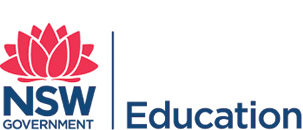
The pandemic has left no aspect of the Australian schools system untouched. Among the impacts of the closures of school buildings were disruptions to periodic assessments that indicate students’ learning progress, including the cancellation of NAPLAN in 2020. It meant that the periods for which students were unable to attend school in person are effectively an academic blind spot for educators.
The NSW Department of Education (NSW DoE) sought to address this by partnering with Janison to assist schools in identifying learning gaps for schoolchildren across the state who had had their schooling disrupted. It followed a successful previous collaboration between Janison and NSW DoE in delivering the diagnostic assessment Best Start Year 7.
The ongoing project, called Check-in assessment, and which began in 2020, resulted in a new blueprint being set for diagnostic testing at state level. Its success led to its expansion for 2021 and Ministerial praise as a “world-class diagnostic tool” that was set to transform how NSW schools measured student progress.
The brief
The NSW DoE wanted to give schools the opportunity to check how their students were tracking in the key areas of literacy and numeracy via an optional diagnostic assessment. The on-demand online test would be delivered to Years 3, 5 and 9. As with Best Start Year 7, key to its effectiveness would be the ability to deliver results swiftly, giving immediate insights for teachers to address key areas of student weakness.
The challenge
The lack of in-person teaching during the COVID-19 lockdowns meant that in some cases, as a result of weeks of school building closures, some students were experiencing a loss of learning and delays in their development. Principals and teachers also faced logistical limitations that affected their ability to deliver traditional pen-and-paper testing to identify who was falling behind. The challenge was to identify which students had missed out and by how much to help inform teachers’ approach to supporting their classes in catching up.
Our solution
The NSW DoE Check-in assessment was central to providing data to pinpoint learning gaps to provide teachers with evidence for much-needed educational interventions during an extraordinary period of external disruption. The online assessment was multiple-choice, which meant that marking could be fully automated, delivering results within 48 hours, which is significant considering that it is typically a 3-month process for traditional paper-based delivery.
It was offered to schools in a three-week window in Term 3, giving them the flexibility to run the assessment at a time that best suited them.
In a letter to staff, the NSW DoE said: “The Check-in assessments are designed to supplement existing school practices to identify how students are performing, and to help teachers tailor their teaching more specifically to student needs.”
The test were designed by the Department and delivered on the Janison Insights assessment platform, integrated with the NSW DoE’s reporting and analytics system, SCOUT. Students sat the online test, and at the end of the day the DoE Reporting team would extract daily results from Janison’s solution, feeding it through to their data warehouse and compiling a report for schools via SCOUT.
The result
Take-up of the test was high, with a total of 1,775 schools and 157,000 students participating during the Term 3 testing window – more than 80 per cent of eligible schools.
Digital delivery and automated marking enabled detailed results to be in teachers’ hands within 48 hours. Delivery was smooth and efficient, with up to 21,000 completions per day for the Year 5 and 9 tests, and as many as 24,000 per day for Year 3. There were a total of 318,000 test completions.
Praise from teachers, ministers and teachers’ union
The 2020 Check-in assessment was applauded as a success by participating schools and stakeholders. One school principal said that the test provided much-needed data on student progress “in a year where we had limited opportunities for a formal assessment process”.
“This is of great benefit to our teachers, particularly in the alternate years to NAPLAN,” he said.
A teacher from another participating school said: “Yes! It’s been great to have results so quickly.”
Minister for Education Sarah Mitchell said: “The response from schools to the Check-in package has been fantastic.” She added: “Feedback from the assessment tool will contribute to the NSW Government’s curriculum overhaul, which will see a renewed focus on literacy and numeracy.”
The NSW Teachers Federation union hailed the project as an “enlightened approach” to assessment, adding: “The Federation congratulates the Minister on the literacy and numeracy Check-in assessment package.”
Feedback has been overwhelmingly positive and is a great example for education ministers across the country. Schools said the major benefits were quick turnaround for results, diagnostic information at syllabus and learning progression level, and ability to use the results to inform their classroom practice.
NSW Minister for Education Sarah Mitchell
Check-in expands for 2021/22
In April 2021, Check-in ran for Years 4, 6 and 8, to allow Years 4 and 6 to compare their results with last year’s, and set up Year 8 for a comparison at a later date. In 2022, 1.2 million Check-in assessments were run for Years 3, 4, 5, 6, 7, 8 and 9 Check-in will also run, across 2,200 NSW Government schools.
“Due to the success of the rollout and how well it was received by schools and teachers, we are anticipating an even greater demand for the insights that these assessments provide” said Derek Welsh, Chief Operating Officer at Janison, adding that due to the continued COVID disruption, private and other non-government schools, were also keen to be part of this landmark initiative.
Speaking publicly, Ms Mitchell described Check-in as a “world-class diagnostic tool” that was set to transform how NSW schools tracked student progress. She said the take-up for 2021 had been “extraordinary”, with more than 90 per cent of primary schools opting in for the new Year 4 and 6 assessments and almost 70 per cent of secondary schools running the Year 8 Check-in.
“Feedback from last year’s assessments has been overwhelmingly positive and is a great example for education ministers across the country,” Ms Mitchell said.
“These assessments provide a snapshot of students’ strengths and weaknesses, and will help schools quickly identify the students with the greatest levels of need.”
She added: “Schools said the major benefits were quick turnaround for results, diagnostic information at syllabus and learning progression level, and ability to use the results to inform their classroom practice.”
David Caspari, Janison Chief Executive Officer, said: “We’re very proud of the role we played with the NSW Department of Education with the Check-in assessment and delighted by the positive outcomes and feedback from schools and teachers.
“We really see Check-in as a force for good. Amid the fallout of COVID-19, teachers and schools are desperate for knowledge and insights about how their students are progressing, and Check-in meets that critical need in a timely manner.”
The roadmap
Minister for Education Sarah Mitchell said: “Following the success of the check in assessments, additional on demand, online assessments and improvements to the existing tests are currently in development.”
Statistics and key milestones
1.2M
test completions in 2022
+80%
of eligible schools took part
48hrs
time within which teachers received results
How instructional design was the key to Centennial College’s education continuity during the pandemic
How instructional design was the key to Centennial College’s education continuity during the pandemic.

Centennial College in Toronto, Ontario, is one of North America’s leading providers of hospitality training. It boasts a world-class Culinary Arts Learning Lab, including a restaurant, hotel rooms, event centre and industrial kitchens. It even mills its own flour. Suffice to say, its hands-on career training is second to none.
But when last year’s COVID-19 lockdown hit, the College, which until then offered limited online options, found itself with just weeks to translate its famously practical learning experiences into a digital medium before the start of semester.
“Our student population up to that point consisted largely of direct entrants, attending in person,” explains Michelle DeCoste, the Dean of Centennial College’s Centre for Part-time and Online Learning, whose popular program areas also include Engineering, Community Health Services, Communication, Media and Arts, as well as Business. What’s more, half of the College’s students originate from overseas, and it was looking increasingly likely that they wouldn’t be able to travel back and forth any longer. “As lockdown loomed, we knew we needed to find ways to operationalise online. And fast.”
The situation set in motion a wave of digital innovation for the College. At its heart, a digital curriculum created through tightly coordinated instructional design and visual development in partnership with Janison and others.
The brief
The College’s Executive moved quickly to provide funding to create a bank of high quality, interactive online programs. A total of 23 to be precise; a number that would rapidly grow to 44 as the College found its digital feet. These 44 programs involved the development of approximately 400 courses. Jo Booth, Senior Manager, Part Time & Online Learning, took up a driving role in turning a typical industry-focused curriculum into a schedule of online experiences that would offer students flexibility, and the College assured revenue streams.
The challenge
Lockdown arrived on 16 March 2020 during the last four weeks of term time, giving Centennial College six weeks to migrate to distance teaching across seven facilities in time for the new term. “The lift was massive,” Jo says.
Despite the time crunch and the enormity of such a shift, the College was adamant no corners would be cut. Every course should deliver high quality and educational value in each learning experience.
A feat of such magnitude needed to be incredibly well coordinated. Centennial set down three rules to govern what was to come:
- Faculty subject matter experts (SMEs) were to be drivers of their own courses, consulted and trained in the use of education technology tools
- Content must be easily adaptable to the needs of each individual faculty (there were seven involved in the Janison project)
- With no available internal human resources to bring to bear, every project was to be full service, including multi-media instructional design, course building, and integration with the College’s learning management system (LMS), D2L Brightspace, a Janison partner.
“Looking back, I wouldn’t advocate for anyone to attempt what we undertook at such short notice; there were more than a few sleepless nights” says Jo. “However, it’s a testimony to our partnership with Janison in designing, developing and operationalising content that together we were able to achieve the seemingly impossible.”
Our solution
Fewer than three weeks after lockdown, on 5 April, Centennial College formally engaged Janison’s instructional design team in a lightning-fast collaboration intended to outpace course delivery dates for the upcoming semester.
In cementing the partnership, Jo had trawled through and assessed a great number of instructional design options before settling on a collaboration with Janison as one of the project partners, owing to Janison’s deep understanding of the online education space. Its Australia-based location was not a factor under the circumstances. Central to the partnership’s success would be the Janison team’s ability to operate as a true extension of the Centennial team, quickly assimilating college culture, objectives and knowledge.
Winning teachers’ confidence
The fact is that a face-to-face teaching experience doesn’t translate literally into an online classroom. So, there needed to be a huge effort up front to understand how students learn online, and to imagine new ways for them to interact with their peers as though in a physical classroom. The same applied to professors, many of whom were anxious about an entirely different teaching experience.
The Centennial project team placed a significant emphasis on change management, facilitating regular Zoom calls between SMEs and Janison instructional designers to ensure a high level of ownership and comfort. Michelle says: “One of our SMEs who initially struggled with the thought of being on video, received great student feedback on the very thing he feared: his videos. They loved them!”
“The relationship between Janison and our SMEs, in particular instructional designers’ in-depth understanding of their anxiety and stress levels associated with an unexpected change to the status quo, was a huge factor in our ability to keep things moving forward,” adds Jo.
Navigating the hands-on challenge
Representing hands-on experiences in a remote format was a sizeable obstacle. Cooking and baking skills fell into that category. The Janison team worked with Culinary Arts professors to come up with digital experiences that provided equivalent value to attending the learning lab. To meet the deadlines of the first round, the team sourced existing videos, on knife usage for example, to incorporate into courses.
Come the summer months, pandemic restrictions had eased partially so that SMEs were able to go into the campus to record their own videos. “This is where we saw real creativity, in Master Chef-quality, highly engaging productions featuring well-known chefs,” says Jo.
Math for Hospitality presented another challenge in an online space, due to the complex symbols typically taught. Centennial worked with Janison to produce bespoke simulations for demonstrating mathematical principles supporting cooking processes. The partnership introduced a whiteboarding technology.

Technology also came into play for enhancing student assessments. Professors increased providing feedback via video annotation. As the Centennial team has increased in proficiency, so too have the experiential components of courses. The college has also integrated apps such as StoryWorks and makerspaces into content across Arts, Design and Engineering programs, providing hands-on, creative ways for students to design, experiment and build while they’re engaging in learning.
The result
Undoubtedly the big win was turnaround time. Both Michelle and Jo can still hardly believe that they were able to go from zero to fully online in six weeks with the first round of courses. “Some courses were not finished before we had to publish them, so that we were adding in new content even as students were progressing,” says Jo, who said she has learned a lot during the project’s initial weeks.
“The Janison team was exemplary in coming to the table with a willingness to deeply understand the various learning elements and a dedication to delivering timely solutions. There was never any question that they were 100 per cent there for our SMEs throughout the process,” she adds.
It’s down to the strength of this working relationship, which Jo describes as “open, honest and respectful on both sides” that 44 fourteen-week programs were delivered in a year of lockdown; sixteen of them during the first six weeks!
It’s a stark truth that educational institutions have borne the brunt of the COVID-19 crisis in loss of enrolments. However, Centennial College was able to maintain continuity throughout by introducing new online programs accessible to a global student community. Moreover, it achieved 24% ROI right out of the gate and is on track to achieve 100% over the next four years.
Even more exciting is the trajectory of domestic enrolment growth, which is steadily inclining with the availability of online course options. “We expected our international student base to increase. The growth of domestic enrolments has been a pleasant surprise,” says Michelle.
Looking back, I wouldn’t advocate for anyone to attempt what we undertook at such short notice; there were more than a few sleepless nights. However, it’s a testimony to our partnership with Janison in designing, developing and operationalising content that together we were able to achieve the seemingly impossible.
Jo Booth, Centennial College Senior Manager, Part Time & Online Learning
The roadmap
With new learning paths defined, a world of opportunities and additional revenue streams has opened. Centennial College is excited about the future of education, in which it imagines a hybrid of digital and physical learning experiences co-existing. A new development in immigration guidelines from the Immigration, Refugee & Citizenship Canada (IRCC) now enables international students to qualify for a post graduate work permit on the basis of education completed online versus on the ground. This throws the College’s doors wide open to a broader international student community.
“These are exciting times,” says Michelle. “And we couldn’t imagine being in the fortunate position we find ourselves in today without Janison’s partnership.”
Statistics and key milestones
600
hours of course material transitioned to a virtual learning environment
16
fourteen-week courses delivered in six weeks
24%
ROI upon launch
Australian Science Innovations continues to discover and nurture young creative scientific minds amid the COVID-19 crisis
Australian Science Innovations continues to discover and nurture young creative scientific minds amid the COVID-19 crisis.
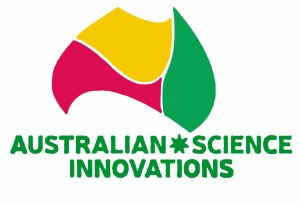
Since 2006, each May, Australian Science Innovations (ASI), has been offering the Big Science Competition to students in Years 7 to 10. The competition is designed to test students’ creative and critical-thinking skills, how they can apply those skills to solve real-world problems and to encourage them to go on to have science and technology engineering and maths (STEM)-based careers.
Amid the COVID-19 novel coronavirus pandemic, most schools, higher education institutions and universities are cancelling or delaying teaching and assessment events. But ASI has opted to forge ahead with this year’s Big Science Competition, using the Janison Insights platform.
“At this time, it’s never been more critical for students to consider the role that science plays in problem-solving – that’s exactly what the Big Science Competition does,” said ASI executive director Ruth Carr.
“[The COVID-19 restrictions] have been really tough for teachers. In the past few weeks their worlds have been turned upside down.
“We want to provide some sort of normality for them. This competition has run in May for the past 14 years. The Janison Insights platform means that teachers and students have flexibility and reliability – they can access it from home; from wherever they are. The only reason we can offer the competition this year is because of Janison Insights.”
The brief
The key reason for ASI’s existence is to run the Australian Science Olympiads program, which targets high performers. ASI developed the Big Science Competition as an entry point to this. The competition is held Australia-wide and internationally, including at schools in New Zealand, Singapore, Thailand and Malaysia. Overall, between 35,000 and 40,000 students take part each year.
In 2014, ASI had heard about the ground-breaking work that Janison was doing in delivering the annual VALID schools science exam for the NSW Department of Education. ASI asked Janison to provide the online platform to allow it to offer an online version of the Big Science Competition, alongside a pen-and-paper option.
The challenge
At that time, online delivery of exams was still a relatively new development. “Back then, teachers were sceptical and reluctant about delivering online. So, we wanted a platform that had already gone into schools and was proven to work. That’s why we chose Janison.”
For ASI, providing an equitable experience to participants was also key. “Of course, we need to make sure that we’re equitable. Not all schools and not all kids have access to the internet nor to a device. So, that’s why we continue to offer a pen-and-paper version of the competition.”
Our solution
The Janison Insights platform allows students to take part in the competition on their own device. “The ability to bring-your-own-device (BYOD) has been one of the reasons we started the online version. Before, kids would have to go to a PC workstation to do the competition, now they can just access it from home, from wherever they are,” said Ruth.
Quick results turnaround
“What the online system has allowed us to do is to provide teachers and students with a really quick turn-around of their results and see their performance on a national scale. Thanks to the online platform, we can turn around the results within 10 days – compared with eight weeks for the pen-and-paper version. It means teachers can then go back to their students and give them almost immediate feedback.
“That’s definitely one of the best outcomes of moving the competition to online.”
Flexibility for students; full control for teachers
The Janison Insights platform provides students with the flexibility they need to be able to participate safely from home, no matter where they’re located.
“One of the top features has been the teacher dashboard that allows the teachers to take control of the test, reset passwords and monitor progress. That’s been really useful and it takes a lot of pressure off our call centre. It’s very easy to use and teachers have been using it successfully.”
The students receive a unique school ID, log on and self-register. They then complete the competition and the teacher can monitor them via the teacher dashboard.
“So, it’s just like they’re sitting in a class for 50 minutes. However we’re going to have to be flexible in these current circumstances. If a student has to do it outside of the virtual classroom setting, we will allow that as well.”
The ability to bring-your-own-device (BYOD) has been one of the reasons we started the online version. Before, kids would have to go to a PC workstation to do the competition, now they can just access it from home, from wherever they are.
Ruth Carr
Executive Director, Australian Science Innovations
The result
Since 2014, the take-up of the online option of the competition has grown steadily, said Ruth. “In 2019 we reached a tipping point, where more than 50 per cent of schools opted to go online rather than pen-and-paper.”
“Teachers are becoming more confident in online platforms and the delivery of it is becoming more reliable. Teachers are also much better at troubleshooting than they were seven years ago and the kids are as well. This is an entire generation that’s come through who are digital natives and are extremely comfortable with the online environment.”
Delivering the Big Science Competition amid COVID-19
“It was both a very tough and very easy decision to go ahead this year. We decided it was worth it. We wanted to provide some sort of normality for students. Students have been doing this in May for the past 14 years and we’d like to continue to provide teachers and students with this regular point in their calendar.
“Because it’s a low-stakes competition there’s nothing to win – that’s the reason we can do this. The questions ask students to digest information and then make a decision. It’s not something that you can cheat in. You can’t Google the answers.”
There’s never been a more critical time to nurture science skills. We also wanted to provide some sort of normality for students. The only reason we can offer the competition this year is because of Janison Insights.
Ruth Carr
The roadmap
“There’s never been a more critical time to nurture science skills,” said Ruth. “Our mission is to ensure that the best and brightest students continue to pursue a career in STEM.
“Over the past six months Australia has dealt with the bushfires; now we’re dealing with the COVID-19 pandemic. By continuing to offer the competition, we’re directly ensuring that we’ve got the best brains available to go on to solve problems like these, and problems that we’re going to be faced with over the coming decades.”
Statistics and key milestones
35,000+
students take part each year
50%+
of students have used the online option since 2019
10days
to receive online results vs 8 weeks for the pen-and-paper competition
Want to learn more about our tailored solutions?
Chat to one of our assessment or learning consultants today.
or call us on 1300 857 687 (Australia) or +61 2 6652 9850 (International)

Transport for NSW transforms driver licence knowledge tests across the state
Transport for NSW transforms driver licence knowledge tests across the state.

Service NSW is hailed by the Australian Government as a “case study” of digital transformation of public services, enjoying customer satisfaction rates of 95 per cent and more.
Part of its success is its recent adoption of Janison Insights to deliver Transport for NSW’s driver licence knowledge testing for thousands of drivers state-wide. The project streamlines the test-taking process into a smooth experience for the public and staff alike.
The brief
Sitting a road rule knowledge test is critical to obtaining a NSW driver’s licence. To ensure that Transport for NSW could continue to deliver these tests to the public in high volumes into the future, it needed to overhaul its legacy system.
Some 600,000 new and existing drivers are predicted to take these knowledge tests in 2019-20. This number is rising by 10 per cent annually as Australia’s population grows. Added to this, Transport for NSW had committed to compelling targets to address road fatalities by 2021.
Transport for NSW wanted to enhance the customer experience via an agile and engaging new Knowledge Test System that could not only deliver efficient testing at scale, but could evolve with driver education activities, road safety trends and operational needs.
The challenge
Transport for NSW’s test delivery process faced several difficulties. Delivering tests was cumbersome for counter staff – each iMac terminal required staff to walk over and stand at the machine to start and supervise each individual test. Delivery of tests was confined to the four walls of the individual service centre on an internal network.
The legacy system lacked flexibility for installing and running new digital services on the terminals. Interfaces were dated, test analytics difficult to capture, and hardware was risky and expensive to maintain.
Our solution
Janison’s cloud-based solution places Transport for NSW’s Knowledge Test System on secured Google Chromebook devices, enabling it to deliver and monitor tests remotely with a push of a button from behind the service centre counter.
The platform delivers 31 variations of the Driver Knowledge, Hazard Perception and Driver Qualification Tests, in 10 languages, and feeds results and data to Transport for NSW in real-time.
Remote delivery capability allows Transport for NSW to make the test available in external locations such as rural areas, police stations and local council agencies. It even travels on “mobile kiosks” on Service NSW buses to remote rural areas.
Chromebooks are pre-prepared with the entire suite of test media, meaning that each device can run bandwidth-hungry content, such as high-definition video touchscreen questions, without burdening Transport for NSW’s network or risking slowdowns and drop-outs.
The in-built test player, Janison Replay, continues running a test, giving candidates an uninterrupted experience amid all kinds of bandwidth quality.
The system collects intricate test data, allowing for deep analysis and insights to inform strategic driver education decisions. Authoring tools allow Transport for NSW to evolve the test and create more engaging questions, including interactive video.
The easily scalable and updatable Software-as-a-Service (SaaS) platform lets Service NSW meet the demand of rising volumes for years to come at a realistic price point.
Part of its success is its recent adoption of Janison Insights to deliver Transport for NSW’s driver licence knowledge testing for thousands of drivers state-wide. The project streamlines the test-taking process into a smooth experience for the public and staff alike.
The process
Janison used collaboration and an agile methodology at each step of the lifecycle of creating the platform. During weekly collaborative showcases and final launch, we checked that each platform feature we built aligned with frontline staff and customer needs.
The result
In mid-2019, Transport for NSW centres in three major Sydney suburbs became the first to use the new platform. Members of the public welcomed the upgrade – with one customer commenting: “It’s like going from Pac-Man to PlayStation.” Following the success of the pilot, Transport for NSW transitioned 141 centres to the new platform by December 2019.
Thanks to Janison’s close collaboration with Transport for NSW during each stage of the platform’s build and design, frontline staff required minimal training to use the system. The rollout was such a success that the project team were nominated for a Transport for NSW recognition award.
The platform equips Transport for NSW to test more candidates with fewer human touchpoints, on infrastructure that is easy to maintain and upgrade for the long-term. All this amounts to a real saving to the taxpayer.
The interface is stable, allowing customers to take their test without risk of being distracted by freezes or drop-outs. When the result of a test has a real impact on the customer’s day-to-day life – the potential to be granted a driver’s licence – a seamless testing experience is paramount. A practice test available via smartphone app helps improve continuous driver education and allows Transport for NSW to connect with young, new drivers.
Overall, the improvements to the system greatly facilitate Transport for NSW’s ability to make a genuine impact on road safety outcomes.
The roadmap
The Transport for NSW solution is the first example of a broader test innovation for Service NSW, with benefits relevant across government departments and features that can be easily adapted to deliver key functions within the public sector.
Statistics and key milestones
600,000
new and existing drivers will take the knowledge tests in 2019-20
31
variations of the Driver Knowledge, Hazard Perception and Driver Qualification Tests run on the platform
141
centres were transitioned to the new platform by December 2019
DonateLife’s LMS helps staff boost organ donation nationwide
DonateLife’s LMS helps staff boost organ donation nationwide.

The Organ and Tissue Authority (OTA) delivers the Australian Government’s program to improve organ and tissue donation and transplantation rates nationwide, via its national DonateLife network.
Organ donation itself is a highly infrequent event. Due to clinical reasons, only around 2 per cent of people who die in hospital can become an organ donor. With donation possible in so few cases, and with so many patients needing a transplant, continuing to increase donation rates is vital.
A key factor is ensuring that the topic is raised in hospitals with grieving families by a trained donation specialist nurse or doctor, and that families are provided with high quality care during the donation process.
Evidence of the power of effective training within the OTA is clear. In 2018, nearly 8 out of 10 Australian families agreed to their loved one becoming an organ donor when they were supported by a trained donation specialist doctor or nurse. This dropped to fewer than 5 out of 10 when there was no trained specialist involved.
The brief
The OTA approached Janison in 2015 because it wanted to improve the consistency of its professional training and be able to offer resources on-demand across the country.
To do this, it needed a centrally-hosted eLearning portal. Fewer than 30 staff work at the OTA, engaging a DonateLife network of about 300 people in 98 hospitals across Australia. The OTA funds the training for these donation specialists, doctors and nurses who are involved in conversations with families.
The OTA wanted:
- a national solution with functionality to make it easier to monitor team members’ training down to individual level, across all states.
- to make it easier to monitor state agency training KPIs.
- to be able to host multimedia modules in a website environment, including podcasts, videos and written training.
- a solution that would grow easily with the organisation’s program and which wouldn’t restrict it from a licensing perspective.
The challenge
DonateLife’s members are spread out across Australia, making it difficult to communicate across agencies and states, as well as track individuals’ training. Until approaching Janison, the OTA was relying on spreadsheets to accomplish this.
The OTA’s training is highly specialised and needs to build delicate communication skills. Amanda Bell, Director of Clinical Programs at the OTA, said: “Organ donation occurs at an extremely traumatic time for families – often following unexpected death – and achieving it is a medically complex process.
“Our professionals receive specialist training to be able to support families because the donation has to take place generally quite quickly following a person’s death, so a lot of our training focus is around communication.”
Modules focus on how to empower families to reach a decision that they will be comfortable with for years to come. Staff need to simultaneously convey the rareness of the opportunity, yet connect to the family’s loved one.
“Families are experiencing such trauma in that moment, but we don’t want them to look back and ask, ‘Why wasn’t I asked about donation?’. So, it’s a very key conversation that our professionals have to have.”
In 2018, of 78,525 deaths that occurred in hospitals, 1,211 potential donors were identified. Requests to families for donation were made in 1,118 cases, with 716 consenting. Of those, in 162 cases donation didn’t proceed for clinical reasons. But the remaining 554 donations saved and transformed the lives of 1,544 organ transplant recipients and their families.
The OTA is a statutory authority of the Australian Government and needed to make careful choices with how it channels its training budget. It wanted to focus most of its budget on creating modules and resources, rather than having to service the platform and IT infrastructure to deliver it.
Our solution
Janison focused on the overall platform and making it easy to administer and navigate, and the OTA partnered with various content providers to develop the eLearning modules.
“You don’t want people spending ages trying to find the content they need,” said a Janison project spokesman. “The modules themselves cover a very sensitive subject. The content needs to be put front and centre, and presented in a very clean, clear way.”
Designing the platform on the cloud meant it could scale and be updated easily and cost-effectively. “The original vision was to get content out to as many people as possible and make that easy, and make it easy for the OTA to grow the site as their program grew.”
Consolidated training
The OTA’s platform consolidates its training programs into a one-stop shop for guidelines, education and training. It has 1,877 active users Australia-wide, including OTA staff, DonateLife Network staff in hospitals and agencies, and broader hospital intensive care and emergency department staff who participate in training.
The platform hosts bespoke content and e-modules, including a podcast series and videos that deliver specialised training, some of which used to only be available face-to-face. These include role plays of the complicated family conversation around organ and tissue donation.
Importantly, there’s also the OTA’s national orientation program for the DonateLife network which needs to be delivered to a variety of professionals. “We designed the course to clearly describe the national program and how a new DonateLife team member’s role fits within that bigger picture,” said Amanda.
“A lot of the staff in DonateLife work in a normal ICU role within a hospital but also some dedicated time within the network’s specialist role. Our platform enables us to deliver a variety of training to staff across different hospitals.”
Administration made easy
Reporting tools and administrator dashboards solve challenges by automating the task of managing specialised training across multiple groups and hospital roles.
Amanda said: “The ability to assign training based on group type is one of the most useful features. We’ve used the platform’s functionality to set up different group types so we can deliver enrolments. Once they attend one module, they’re assigned to a group and then they get training delivered automatically that’s specific to their needs.”
Notification tools that unite disparate teams
Notification features make it easier to communicate quickly across multiple groups, Amanda said, adding: “We recently did some redesign work on the platform and added new content, so just having that ability to reach everybody with the press of the button is excellent. We can tell them ‘check out what’s new’, and where to find it.”
User profile tools
The platform’s profiling tools simplify the task of administering training for a national program. Amanda said: “We can assign administrator rights to people based in the state agencies – being able to do that has really cut back the workload and increased the accuracy of user profiles.
“We’re able to create new profiles when people join the network with different group identifiers and access. We don’t necessarily know when staff come on board or leave individual hospitals, so giving that administrator right enables states to keep their own systems up-to-date at a more granular level.
“They can then update the staff profiles, activate them and report on all their own staff training.”
Customised reporting
Reporting tools ease the management workload for the OTA at state level. “The states can use the system to generate reports, plus look at activity at that local level. This enables them to pull information or filter it in whichever way they need.”
The result
The Janison Academy platform continues to grow as the OTA’s work grows, with 1,877 active users across the country, and approximately 325 new users joining per year.
The OTA says that the capability of the platform has been extremely useful in allowing it to be dynamic and change with the new directions that the organisation takes to its learning and development. This is demonstrated by the impressive take-up among current active users: 98 per cent have attended the OTA’s core training workshop and 53 per cent have completed its more advanced practical workshop.
Amanda said: “The feedback we receive has also been very positive, especially in regards to our new learning modules which, because of the capability of the system, have been able to be targeted at our DonateLife staff.
“The modules were completed by 27 per cent of the targeted group within one month of going live. This for us is a big win, because these are the people who are on the ground having the important conversations with families to help them make an important decision and any help we can provide them in this important task is fantastic and this platform lets us do that.”
The modules were completed by 27 per cent of the targeted group within one month of going live. This is a big win, because these are the people who are on the ground having the important conversations with families.
Amanda Bell
Director of Clinical Programs, Organ and Tissue Authority
Statistics and key milestones
1,877
active users Australia-wide
98%
of users have attended the OTA's core training workshop
325
new users joining every year
An online literacy and numeracy exam that paves the way to success for NSW Year 7 students
An online literacy and numeracy exam that paves the way to success for NSW Year 7 students.

The NSW Department of Education (NSW DoE) selected Janison to build and deliver a new assessment under the Literacy and Numeracy Strategy 2017-2020, a four-year plan to ensure students have the essential literacy and numeracy skills they need for success in learning and in life.
The brief
The Department was looking for a specialist digital assessment provider to help it achieve the key aim of the new assessment: to quickly identify students at risk of falling behind and pinpoint what type of support they need. The window for the opt-in assessment, called Best Start Year 7, would run over 31 school days in February-March 2019, for more than 40,000 students across the state.
As well as offering government-grade reliability and security, the solution needed to be Software-as-a-Service (SaaS) that scales easily year to year and seamlessly integrates with all schools’ existing systems. Examiners also required the ability to author and deliver a number of different question types to create an engaging test for school students.
The challenge
As acknowledged by former Minister for Education, Adrian Piccoli, in the strategy document, literacy and numeracy skills are the foundation for the next generation’s success in learning and in life. It’s critical for students to develop confidence in these skills, and falling behind can have devastating consequences for their secondary schooling.
The Department entrusted Janison to deliver technology that could provide precise evaluation of students’ skills at a critical juncture in their education – the first weeks of Year 7 – and quickly provide intricate diagnostic data to inform teaching intervention.
As sophisticated as the technology needed to be, it also needed to be user friendly to cater to all levels of technical literacy among teaching staff. It also had to be built to operate seamlessly within greatly varying levels of IT infrastructure between the 321 schools across the state taking part.
Our solution
Best Start Year 7 demanded a sophisticated online platform that could efficiently deliver and process a considerable daily number of student test completions and feed a large volume of real-time data into NSW DoE systems, making valuable analytical information available for teachers almost instantly.
Janison partnered with the NSW DoE and tailored our cloud-based platform, Janison Insights, which delivers assessments for governments around the world, to deliver on these key needs.
Through collaborative weekly video conferences and conversations with key NSW DoE stakeholders, Janison’s project team pinpointed the necessary features and adaptations to allow teachers to more easily perform tasks within the system, including authoring tools that allowed for a wide selection of question types. During the project meetings, Janison and NSW DoE clearly demarcated responsibility in managing the school IT networks, to allow for the smoothest possible running of the exam window.
The result
A NSW DoE survey of 293 early adopter schools who took part in a Best Start Year 7 professional training pilot, found that more than 95 per cent agreed that the exam will help to identify students requiring additional support in literacy and numeracy.
Janison hosted the live Best Start Year 7 assessment event over 31 school days, which comprised three streams: reading, numeracy and writing. We delivered the end-to-end online assessment solution to schools across the state, including the set-up, configuration, hosting, data extract, support and marking.
A total of 41,000 students sat these assessments, with an average of 2,400 tests completed daily. The highest number of tests in one day during the exam period was 6,673.
The system auto-marked the literacy and numeracy portions, enabling real-time data delivery to the NSW DoE, while the platform’s discrete marking features streamlined the marking process for the teachers who marked the writing portion of the exam. The platform operated seamlessly with schools’ existing IT infrastructure, including student devices such as laptops, desktops, PCs, Chromebooks, iPads and Android tablets.
Janison’s operations team carried out real-time monitoring of the infrastructure and application performance throughout the 31-day window, to ensure that any potential issues could be dealt with instantly. There were no delivery problems or slowdowns reported and NSW DoE stakeholders commended the smooth end-to-end delivery of the assessment and analysis data.
Janison has worked collaboratively with the Best Start Year 7 team to successfully deliver an online literacy and numeracy assessment to NSW Department of Education students. Teachers administering the test found the system easy to use and the online format successfully engaged students to demonstrate their skills and understanding.
NSW Department of Education spokesman
Speaking of the assessment event, a Department spokesman said: “Janison has worked collaboratively with the Best Start Year 7 team to successfully deliver an online literacy and numeracy assessment to NSW Department of Education students.”
“Teachers administering the test found the system easy to use and the online format successfully engaged students to demonstrate their skills and understanding.”
Statistics and key milestones
41,000
students across NSW sat the inaugural Best Start Year 7 exam in 2019
>6,673
completions per day
75,000
tests completed
British Council takes its English language testing beyond borders
British Council takes its English language testing beyond borders.

In early 2017, the British Council partnered with Janison to create a new platform to deliver their internationally recognised English language proficiency test, Aptis.
The British Council offers Aptis globally in more than 100 countries across government, educational and business sectors, to some of the most remote and technically challenging locations in the world.
Aptis tests, delivered in British Council test venues, are targeted at test-takers who need to demonstrate their proficiency in the English language with the aim of moving countries, gaining an employment promotion or entry to study – critical, life-changing outcomes and opportunities for the candidate.
Thanks to award-winning technology created by Janison, these opportunities have been considerably widened, particularly to populations in highly remote or developing countries for whom poor or no internet connectivity has been a barrier to accessing online assessments.
Jonathan Ford, global head of assessment at British Council, said: “English language testing stands above other subjects, because it is an enabling set of skills and competencies.
“It’s not just about our work and professional existence – it’s also about communicating and bridging between different communities and cultures.”
The brief
In 2020, COVID-19 lockdowns and social distancing restrictions effectively halted Aptis delivery in its tracks, as candidates were blocked from physically going into test centres. With its revenue streams dried up, British Council approached Janison to innovate a solution to this key business continuity issue and allow it to continue to be able to deliver quality-assured tests directly to the safety candidates’ homes.
Being able to access Aptis was particularly important for employers at this time, as workforces were shifted to remote work and employees needed to prove their language proficiency. It meant that any solution needed to be rolled out very swiftly.
The challenge
The initial critical challenges for British Council to delivering consistent testing around the world is varying access to secure computer facilities and poor online connectivity. When it first approached Janison, its legacy test-delivery solution was based on Adobe Flash technology which had limited support across operating platforms and was neither scalable, flexible nor reliable.
During 2020, this challenge shifted to the logistics of delivering Aptis directly to students via remote proctoring technology. Online proctoring adds another layer to the process of delivering a digital test – requiring the candidate to install a test application onto their device. This involves ensuring that candidates receive clear instructions and relying on local centres – in British Council’s case, 10 countries including Mexico, Saudi Arabia and the UK – to administer the tests.
The solution
Leveraging Janison’s global leading assessment platform, Janison Insights, Janison designed and developed innovative new technology, called Janison Replay, an assessment player with a wide variety of options for effective and reliable test delivery. It has a unique capability to seamlessly transition between online and offline modes.
It allows tests to be taken on a variety of different devices and in the event of a connectivity drop-out, it ensures that the test session data continues to track locally, providing a rich, consistent, seemingly uninterrupted offline test-taking experience but still within a familiar modern browser-based environment. It means that poor internet – or indeed, no internet – is no longer a barrier.
Even when offline, the application remains interactive, displaying test content, supporting navigation and storing test results. The test-taker is not even aware of a dropout – and continues an uninterrupted test-taking experience.
Upon completion of the test, Janison Replay will attempt to automatically synchronise the test results, but in the event of further disruption, the test invigilator can reconcile the data on the device and upload the candidates’ responses back to the Janison Insights platform via a secure export process.
In scenarios where the internet is not available at all, any device can be prepared beforehand to run completely offline but act like it’s delivering a live online test. This is one of Janison Replay’s greatest strengths – exactly the same testing experience is delivered either online or offline on any device and in any location that British Council finds its customers.
During COVID-19, when lockdowns shut down candidates’ physical access to test centres, Janison implemented Janison Remote, its online remote proctoring solution, which enabled British Council to deliver Aptis directly to candidates in their homes. For bandwidth resilience, the browser-based version of Janison Replay ran in the background to ensure the tests proceeded uninterrupted.
Rollout and beyond
Janison Replay allowed the full suite of Aptis assessments to be conducted on the one platform for a candidate. Grammar, vocabulary, reading, writing, listening and speaking tests can all be taken online without the need for skilled examiners in the room.
This allows examiners to be able to measure the proficiency of any candidate seamlessly on the other side of the world, without the need to travel.
In 2020, during the pandemic, this capability was extended with Janison Remote, allowing candidates to validate their English language proficiency without leaving their homes. Whilst time was of the essence, Janison’s operations team wanted to maintain the utmost quality and reliability in the rollout. This meant a series of pilots needed to run with British Council’s teams to first to prove out the process and technology. The pilots ran in Mexico, the Philippines and China.
If you strap together British Council’s ability in language and its coverage of the globe with technology – then you can get something very special. The technology makes it available. You get not just the power to test, but the power to develop people personally.
Jonathan Ford
Global Head of Assessment, British Council
The result
In 2017, within just six months British Council successfully delivered Aptis on the new Janison Replay assessment player to more than 115,000 candidates in 78 countries, from India, to Colombia, the Philippines and the UAE. The solution won acclaim for Janison, including a place on the Australian Financial Review’s Top 100 Most Innovative Companies 2018, as well as the public sector category of the 2018 iAwards.
Jonathan Ford said: “If you strap together British Council’s ability in language and its coverage of the globe with technology – then you get something very special. The technology makes it available. You get not just the power to test, but the power to develop people personally.
“People don’t take Aptis just once, they take it several times. It’s all about their growth and improvement and personal development: enabling state school kids in provinces in China to learn and test their English; or in Andhra Pradesh, where we’re working with students looking to enhance their employability.”
In 2020, the remote solution was heavily adopted in Mexico, as well as across India and in the UK, for workers in the National Health Service (NHS). In total, 10 countries successfully rolled out the Janison Remote Aptis solution.
Statistics and key milestones
3.3M+
Aptis tests
delivered online and remotely since 2017
100+
countries
delivering Aptis online and remotely
660,000
candidates
have taken part in Aptis since Janison took on the project
Primary Ethics uses the power of Janison Academy to equip communities statewide to deliver ethics skills to school children
Primary Ethics uses the power of Janison Academy to equip communities statewide to deliver ethics skills to school children.
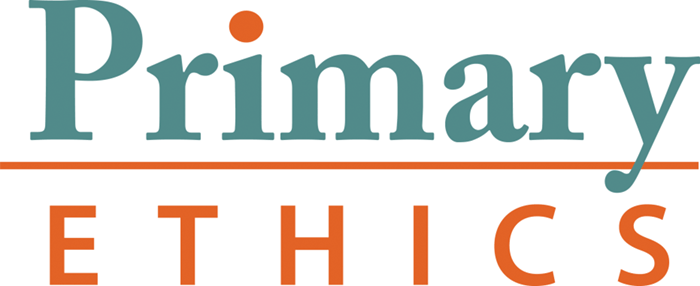
Primary Ethics is a NSW not-for-profit organisation that trains volunteers to deliver ethics classes to children in primary schools across the state, working in conjunction with the NSW Department of Education.
In the classes, children learn to consider ethical issues, exchange ideas with others and make well-reasoned decisions. Teachers pose hypothetical scenarios and questions to prompt discussions on questions such as “What counts as stealing?”, “Is it ever okay to be lazy?”, or “Is it ever okay to brag?”.
Heidi McElnea, communications manager at Primary Ethics, said: “As children work through these scenarios they start to explore grey areas. They develop the skills to think critically and take a range of aspects of a situation into account, rather than hold absolute views.”
Building training resources with impact
A key aspect of Primary Ethics’ offering is its bank of authoritative and in-depth training resources for volunteer teachers via its website portal. It represents a unique learning and development opportunity for volunteers from a range of backgrounds.
An appetite for secular ethics education continues to grow among schools, parents and volunteers. Year on year, Primary Ethics’ registration and enrolment numbers rise steadily.
“We’ve developed a curriculum and training materials that have universal applications,” says Heidi. “The process of having thousands of volunteers being trained and experiencing these kinds of discussions with children – it’s creating a ripple effect for change that’s really exciting to be a part of.”
The process of having thousands of volunteers being trained and experiencing these kinds of discussions with children – it’s creating a ripple effect for change that’s really exciting to be a part of.

Heidi McElnea
Communications Manager,
Primary Ethics
The brief
In 2010, Primary Ethics approached Janison to provide the tools for its mission to run ethics programs for primary school children.
It’s a considerable task. A handful of staff coordinates 3,000 volunteers who fill a variety of roles in delivering ethics education to 40,000 students. It means the organisation needs a consolidated, reliable and scalable portal to organise and track essentials such as mandatory working with children modules, criminal background checks, enrolments, as well as the training modules themselves.
The challenge
The Primary Ethics volunteer base has a complex make-up, including teachers, ethics coordinators and regional managers. This means that any learning platform needs to go beyond a one-size-fits all approach, and allow the team to easily customise training according to the user’s role and stage of their volunteering career and, critically, ensure that they maintain compliance.
The platform also needs to be able to handle an in-depth onboarding process.
Training manager Karen Lee says: “Our onboarding is quite complex, with quite a lot of prompts to the training. It’s not as simple as just one or two induction modules – it’s quite a journey that our volunteers undertake.”
Steady growth in the popularity of the classes also means that Primary Ethics needs to be able to scale up its programs easily to accommodate a significant influx of volunteers and schools. Karen says: “Soon we’ll be managing double our current volunteer numbers and we need to gear up for that. We had a 50 per cent increase in applicants for volunteering over just three months this year.”
Our solution
Since 2011, the Janison Academy platform has played a critical role in Primary Ethics’ delivery of online training, compliance, authorisation and reporting.
Features that streamline day-to-day essentials
“Before we had the platform, it was really hard for volunteer managers to see who was in their team,” said Karen. “Our team is not straightforward – a particular volunteer can hold more than one role and report to more than one manager. They can also be working at two different schools, where they have two different ethics coordinators. Using the roles and positions feature in the platform really helps us manage and track who’s reporting to who.”
The seamlessness and touch points really assist users, and this continues to the moment they step into the classroom as an ethics teacher.
Karen Lee
Training Manager, Primary Ethics
Tracking compliance is another key task that’s been made easier, Karen said. “When you have 3,000 volunteers, you need a system that you can rely on, especially for annual child protection compliance certificates. We rely on the customisable reports a lot for this. We’ve set them up so that managers can just hit a button and run the reports and get the information that they need about their volunteers’ compliance status.”
The team also make use of features such as sticky notes alerts for important messages. “We can set up a sticky note so that if a particular group logs into the system they can see for example a reminder to complete a certain course,” says Karen. “We can customise who gets which messages, which is much better than a bulk email and has more impact. And it’s harder to ignore than an email because it pops up on the user’s dashboard and stays there until they read it and close it.”
Smooth user experience
Customisable features within the Janison Academy platform meant that Primary Ethics could set up a self-registration feature on the website this year.
Karen said: “It means that we’re no longer passing information back and forth between two systems – straight from our website, new users can begin to apply and set up their own account, and we can give them the information they need right from the very first interaction.
“The seamlessness and touch points really assist users, and this continues to the moment they step into the classroom as an ethics teacher. It also of course reflects very well on our brand.”
The result
The capabilities afforded by Janison Academy have allowed Primary Ethics to embrace its fast expansion and maintain a high quality of volunteer training and classes.
Many of the obstacles that the organisation was facing previously in terms of setting up programs in schools have been lessened, she added, and have streamlined the process for parents enrolling their children. “One of the big impacts of that is we’ve had a lot more enrolments, as well as a lot more volunteers applying,” says Heidi.
One volunteer told us ‘I’ve worked for a lot of corporations and this is the best onboarding that I’ve ever experienced.’
Heidi McElnea
The organisation conducts regular surveys among volunteers to track how well it’s customising the system for the best user experience. “We quite often get feedback from users such as how excellent the onboarding and training is,” says Heidi.
“One volunteer told us ‘I’ve worked for a lot of corporations and this is the best onboarding that I’ve ever experienced.’”
An independent review of the Primary Ethics curriculum released in 2017 found it to be of high quality and praised the organisation’s robust training and authorisation processes.
Heidi says: “The Janison product plays such a big role in consolidating all the different arms of our organisation. If we didn’t have it, it would be very decentralised with lots of separate systems that don’t talk to each other very well. We really like that it’s a one-stop shop.
Thanks to Janison, we’re better able to help prepare the next generation with critical thinking and ethical reasoning skills to help them feel more confident to make better decisions in their lives, now and into the future.
Heidi McElnea
“The support we get from Janison with our scaling up is fabulous,” says Karen. “They’re very responsive and they don’t laugh at me when I ask technical questions.”
Heidi added: “Thanks to Janison, we’re better able to help prepare the next generation with critical thinking and ethical reasoning skills to help them feel more confident to make better decisions in their lives, now and into the future. We really want to thank Janison for the support they’ve given this project over the years.”
Statistics and key milestones
3,476
3,476 online completions for induction, compliance and CPD courses in 2018
7,500
volunteers trained on the Janison Academy platform since 2011
763
new ethics teachers received full training in 2018
Want to learn more about our tailored solutions?
Chat to one of our assessment or learning consultants today.
or call us on 1300 857 687 (Australia) or +61 2 6652 9850 (International)

The NSW Department of Education re-engages Year 6, 8 and 10 science students with its VALID online test
The NSW Department of Education re-engages Year 6, 8 and 10 science students with its VALID online test.

In 2010, the NSW Department of Education (NSW DoE) approached us to help it shift its annual Year 6, 8 and 10 science testing from paper-based tests to online assessment. As part of a wider commitment to improving science results, the Department also wanted to give students authentic, interactive test experiences.
The challenge
At the time, delivering a large scale online school assessment was unprecedented. Supporting tens of thousands of students on the platform simultaneously posed a variety of technological challenges, particularly managing data loads. Stable, consistent delivery was vital. The platform would also need to meet the Government’s strict data sovereignty requirements.
Our solution
For the platform, we addressed key scalability, delivery and security challenges by taking a unique approach to services and architecture. We addressed data sovereignty by designing the application so that a minimum and acceptable amount of student data was stored in the cloud server environment, and only for the duration of the event.
We built multi-media tools into the exam authoring features. These allowed educators to author questions using animation that simulates practical classroom exercises, allowing students to work with virtual beakers, test tubes and measurement tools on the screen.
The result
In October 2010, Janison delivered what was then a world-first: the first standardised, successful, large-scale online assessment to nearly 40,000 students from 650 schools in one day. In 2015, more than 100,000 test attempts were delivered and marked. By 2016, the test program had doubled to 81,300 students.
Feedback from teachers involved in the early stages of the project was that the Validation of Assessment for Learning and Individual Development (VALID) had transformed from being seen by students as a dull and dreaded exam into a test that pupils now actually looked forward to. Teachers report that they’ve never seen some of their students as engaged in a classroom activity as they are when they’re participating in VALID.
We are delighted with the results. Janison are great to work with and are really leading innovation in this space.
Eric Jamieson, former Director of Education Management, NSW Department of Education
The roadmap
The VALID online assessment platform set the standard for Janison’s digital exams solutions for schools and we’re continually advancing its authoring, delivery, analysis and marking features. Due to the success of the approach, the NSW DoE has asked us to apply the VALID solution framework to a number of its other schools assessment projects.
Statistics and key milestones
40,000
students from 650 schools sat the test in one day in 2010
81,300
pupils took the exam in 2016 – double the pilot number
20,000



